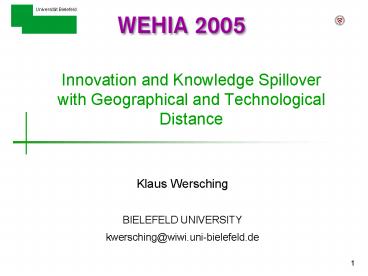Innovation and Knowledge Spillover with Geographical and Technological Distance - PowerPoint PPT Presentation
1 / 20
Title:
Innovation and Knowledge Spillover with Geographical and Technological Distance
Description:
Periphery: No involuntary loss of knowledge. Technological distance: ... all firms are always in the periphery, no learning between firms. 50% core: ... – PowerPoint PPT presentation
Number of Views:93
Avg rating:3.0/5.0
Title: Innovation and Knowledge Spillover with Geographical and Technological Distance
1
Innovation and Knowledge Spillover with
Geographical and Technological Distance
- Klaus Wersching
- BIELEFELD UNIVERSITY
- kwersching_at_wiwi.uni-bielefeld.de
2
Contents
- Introduction
- The Agent Based Simulation Model
- Simulation Setup
- Results of the Simulation Studies
- Conclusions
3
I. Introduction
- Innovation crucial for understanding economic
growth - Knowledge is basis for innovation
- Learning (knowledge spillover) is influenced by
- Geographical distance (e.g. Asheim and Gertler,
2005) - Technological distance (e.g. Nooteboom, 2000)
4
Aims and Features
- Aim better understanding of
- Technological and geographical location decision
of firms - Evolution of specific knowledge in an industry
- Features of the model
- Dynamic perspective
- Industry with differentiated products
- Heterogeneous agents interact on product markets
and exchange knowledge - Process and product innovations
5
II. The Agent Based Simulation Model
- Model is based on Dawid and Reimann (2004, 2005)
- Extension heterogeneous knowledge spillover
6
- Technological distance
- Path on circular Technology Space
- Difference in level of knowledge
- Geographical distance
- Core / Cluster
- Learning from competitors
- Cost of scarce resources (e.g. rents, congestion)
- Periphery
- No involuntary loss of knowledge
7
Decision Making of Firms
- Geographical location according to location
evaluation - Additional cost of the scarce resources
- Potential knowledge spillover in the core
- Technological lead in certain technologies
- Technological location based on market
evaluation - Profits
- Technological distance to own technological focus
8
Knowledge and Innovations
- Knowledge stocks for process innovations and
product innovations - Knowledge increases by own RD and by knowledge
spillover - Firms differ in their RD capabilities
- Process innovations are deterministic and reduce
per unit costs - Product innovations are stochastic and generate
new submarkets
9
Knowledge Spillovers
- Knowledge spillover
- Geographical distance
- Technological distance
- Absorptive capacity
- Technological gap
10
III. Simulation Setup
- 100 runs over 100 periods
- Starting with 5 sub-markets, uniformly
distributed over the technology space - 10 firms with random knowledge, firm strategies
and geographical location - Regarding the impact of different spatial firm
distributions on the technological development
11
IV. Results of the Simulation Studies
- Relevance of geographical proximity
12
Comparison of four scenarios
- 0 core
- all firms are always in the periphery, no
learning between firms - 50 core
- Half of the firms are always located in the core
- Variable
- Decision rule for changing location
- 100 core
- All firms are always in the core
13
Number of successful Product innovations
- Number of successful product innovations raises
with more firms exchanging knowledge
14
Maximum Level of Process Innovations
- Process innovations are highest in the case with
variable location
15
Average Level of Savings after 100 Periods
- Results for the average profitability are similar
in scenarios with fixed location
16
V. Conclusions
- Micro-funded simulation model describes industry
evolution and learning processes - Focus on strategic decision of geographical and
technological location - Results
- Geographical proximity matters for the
technological development of an industry - Firms are indifferent whether all located in the
core or all in the periphery ? room for economic
policy
17
- Next Technological Specialisation of Firms and
Cluster
18
Appendix References
19
(No Transcript)
20
(No Transcript)

